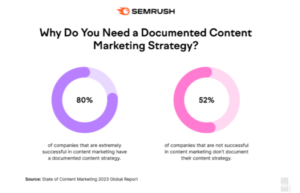Think your content marketing is cutting it? Think again.
Did you know that 80% of marketers with kickass content strategies have a documented plan in place?

Source: SEMRush
It’s true. Winging it with your content will only take you so far. If you really want your marketing to convert and compel, you need to get strategic.
In this article, I’m going to show you exactly how to create a beast of a content marketing plan that attracts, engages, and delights audiences all the way to purchase.
You’ll get actionable tips to set compelling goals, get crystal clear on your audience, create killer content, and optimize like a shark based on hard data.
Get ready to take your content game to stratospheric levels. Let’s do this!
1. Define Your Content Marketing Goals
- Define Your Content Marketing Goals
Having unambiguous, precise goals is the foundation of any successful content marketing strategy. Before creating any content, clearly define what you want it to achieve. Common content marketing goals include:
- Increasing website traffic – set specific targets for unique visitors, pageviews, etc.
- Improving SEO rankings – target specific keyword rankings, organic traffic share, etc.
- Growing your email list – quantify your list growth goals over time.
- Generating more leads – set lead quantity and quality goals.
- Boosting sales – target specific revenue and conversion goals.
Use the SMART framework – Specific, Measurable, Achievable, Relevant, and Time-bound – to set tangible, results-oriented goals. Align your goals with wider business objectives and metrics. Include quantifiable KPIs to track progress.
For example, a SMART goal could be “Increase monthly organic website traffic by 25%, generating 50 more leads per month within 9 months.” Review goals regularly.
2. Understand Your Target Audience
Truly understanding your target audience is essential for creating engaging, relevant content tailored to their needs. Conduct in-depth audience research through:
- Online surveys – gain insights into their challenges, interests, and preferences.
- Interviews – have real conversations to understand motivations.
- Analytics – glean data on demographics, and behavior from your website/social data.
- Social listening – learn about interests and pain points from social conversations.
- Marketing automation – leverage behavioral data to understand your leads.

Develop detailed buyer personas synthesizing your research to represent your core customer groups, including details like:
- Demographics – age, location, gender, job title
- Challenges – pain points they face
- Needs – what they look for in a solution
- Behaviors – where they spend time online, how they research
- Objections – what stops them from purchasing
Map personas to their buyer’s journey stages to inform content. For example, use educational content to attract new visitors and more promotional content to nurture leads. Let your personas guide all aspects of your content strategy.
3. Conduct a Content Audit
Conducting a comprehensive audit of your existing content is critical for gaining strategic insights to optimize your content marketing. Follow these steps:
- Build an extensive content inventory documenting all content assets – every blog post, ebook, video, podcast, etc. Include key information like topics, publication dates, formats.
- Analyze quantitative performance metrics for each content piece, including traffic, leads generated, conversions, backlinks, social shares. Evaluate topic relevance to your brand.
- Assess the qualitative aspects including SEO optimization, formatting, design, length, readability. Review if the content provides value to your personas.
- Identify content gaps by comparing your current content to your ideal content mix that aligns to goals and audience needs. Spot outdated, underperforming or redundant content to prune.
- Evaluate distribution and promotion channels to identify opportunities for better amplification.
- Synthesize findings into a report with data-backed recommendations for capitalizing on high-potential content, improving or updating underutilized content, creating new content to fill gaps.
Leverage analytics tools like SEMrush, BuzzSumo and Google Analytics to conduct data-driven audits. Use the insights to optimize your editorial calendar and content strategy.
4. Create an Editorial Calendar
A comprehensive editorial calendar is essential for executing a consistent, high-performing content marketing strategy. Here are some best practices:
- Select a centralized calendar format that enables collaboration – Google Sheets, Trello boards, CoSchedule.
- Map out all planned content across months, weeks and days – outline content types, topics, formats, lengths.
- Set clear internal deadlines for content creation, revision, approval and promotion. Assign team members to each task.
- Categorize content buckets aligned to your strategy – ebooks for lead gen, videos for retention, etc. Identify topics and formats tailored to personas.
- Document SEO keywords and optimization plans for each piece.
- Build in systems for ensuring quality control through reviews and iterations.
- Include processes for promotion via email, social media, pay-per-click campaigns.
- Track performance metrics over time and optimize based on insights.
Use advanced tools like CoSchedule or Trello to streamline calendar creation, scheduling, and team workflows. Let your calendar set the cadence for publishing engaging, high-quality content mapped to your goals.
5. Produce and Distribute Quality Content
Creating remarkable, valuable content is critical for meeting your goals and connecting with your audience. Conduct extensive research using credible sources to develop original, insightful content. Optimize each piece for SEO by including relevant keywords, meta descriptions, alt text, etc.
Provide truly useful information tailored specifically to your persona’s needs and challenges. Add unique perspectives and bits of personality to make your content memorable. Proofread thoroughly and refine your content through multiple drafts. Use visuals like images, charts, and videos to make your content more engaging and easy to digest.
Strategically distribute your polished content across the right mix of channels and formats to maximize reach. Promote new content through email newsletters, social media posts, and pay-per-click ads. Match the channel to the content type for optimal results; for example, in-depth guides on your blog and short engaging snippets on social media. Optimize each piece of content for its distribution platform. Spread out promotion over time rather than just at launch.
6. Measure and Optimize Your Content Marketing Strategy
Measuring your content’s performance and continuously optimizing based on data insights is essential for improvement. Start by defining your most important quantifiable KPIs based on your goals, such as traffic, leads generated, conversions, etc.
Rigorously track and analyze metrics for each content asset using analytics tools. Identify high-performing content to double down on, and lower-performing content that needs improvement. A/B test different content variables like topics, headlines, formats, and calls-to-action and carefully compare the results.
Conduct ongoing audience and competitive research to make smart optimization decisions. Implement real user feedback into your strategy. Refresh outdated or underperforming content as needed. Continuously assess your content against your goals and use hard data to optimize your strategy over time.
Wrap Up
I hope you enjoyed this list of tips for improving your content marketing strategy! Applying these best practices for setting goals, understanding your audience, auditing and planning content, and optimizing based on data can help you create a high-performing strategy. Let me know which tips you found most useful in the comments, and please share this article if you found it helpful!
FAQs Suggestions
How do you create an effective content marketing strategy?
Start by clearly defining your goals and KPIs. Research to understand your target audience and create buyer personas. Audit your existing content to identify gaps. Map out an editorial calendar to plan content aligned to your strategy. Develop high-quality, valuable content tailored to your audience. Promote and distribute content across channels. Rigorously measure performance and continuously optimize.
How can I improve my content strategy?
Conduct a content audit to analyze what’s working and not working. Research your audience insights to realign with their needs. Set data-driven goals and document your strategy. Improve SEO optimization and amplify distribution. Refresh or repurpose stagnant content. Measure KPIs and optimize based on insights.
How do you optimize content marketing strategy?
Conduct A/B testing of content elements. Analyze competition and audience trends to identify opportunities. Double down on high-performing content topics and formats. Improve or repurpose underperforming content. Research keywords and optimize content. Expand distribution channels and cadence. Implement reader feedback.
